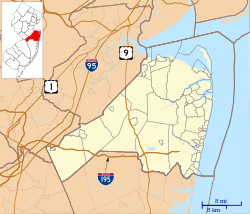Cream Ridge, New Jersey
| Cream Ridge, New Jersey | |
|---|---|
| Unincorporated community | |

Center of Cream Ridge at CR 539 and Burlington Path Road
|
|
| Location of Cream Ridge in Monmouth County Inset: Location of county within the state of New Jersey | |
| Coordinates: 40°08′06″N 74°31′27″W / 40.13500°N 74.52417°WCoordinates: 40°08′06″N 74°31′27″W / 40.13500°N 74.52417°W | |
| Country |
|
| State |
|
| County | Monmouth |
| Township | Upper Freehold |
| Elevation | 131 ft (40 m) |
| GNIS feature ID | 875715 |
Cream Ridge is an unincorporated community located within Upper Freehold Township in Monmouth County, New Jersey, United States. The rural area is made up of farmland (including many horse farms) with small businesses located along County Route 539 and many homes dotting the landscape. The soil in Cream Ridge is Freehold Loam, which is some of the richest soil in the State of New Jersey. Many of the early residents became relatively wealthy "gentleman" farmers, with the actual farm work done by tenant farmers. Most of the early families were Presbyterians, Quakers, or Northern Baptists. Some of the surnames associated with the area are Holmes, Meirs, Rue, Cox, Wright, Lawrence, and Ridgway. Nathaniel Scudder Rue, Jr., the Founder and first President of the Pemberton & Hightstown Railroad (later the Union Transportation Company), lived in Cream Ridge. He was also the Founder of the First National Bank of Hightstown, the first national bank chartered in New Jersey. Nathaniel Scudder Rue's son, James Lawrence Rue, served in the New Jersey State Legislature. The "gentleman" farmer lifestyle was dramatically curtailed during the Great Depression and after WWII, although remnants of this bygone lifestyle existed into the 1980's.
...
Wikipedia



